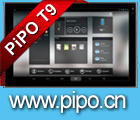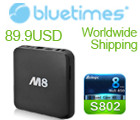Samsung use the Qualcomm Snapdragon 8cx ARM processor on 7nm system-on-a-chip (40% faster CPU, 80% faster GPU compared to Galaxy Book 2), runs Windows 10, with 23 hours of battery, gigabit LTE, always on, always connected, touch-to-wake, instant-on feature, 0.96kg weight, 13.3″ 1080p, multi-touch display (10 points), 1TB SSD, AKG stereo sound with Dolby Atmos support, 8GB LPDDR4X RAM, MicroSD slot, 720p front-facing camera, Wi-Fi 802.11 a/b/g/n/ac, Bluetooth 5.0, USB-C port, and Windows Hello sign-in via a fingerprint sensor. The laptop’s dimensions are 305.2×203.2×6.2-11.8 mm.
Category: Android
BOE 12.3″ Rollable Phone, 7.7″ Foldable Phone, 65″ BD LCD, Printed OLED, 8K VR, Automotive, mini-LED
At SID Display Week 2019, BOE shows their latest 12.3″ Rollable Phone, 7.7″ Foldable Phone, many other flexible displays, UHD displays, micro-displays, other world-leading technologies and innovative applications such as their Smart driving experience brought by flexible display for the Internet of Vehicles (IoV) comprising a smart driver cabin and a spliced display screen of three units in three rows with only 0.99 mm bezels allowing visitors to experience a brand-new in-car display solution of the future. In addition to flexible display applications, BOE also displays the world-leading UHD display solution called the BD CELL UHD display which features an ultra-high static contrast ratio of up to 1,000,000:1, a bit depth of 12 bit, and a black field brightness of less than 0.003 nits, BOE also presents a host of 8K products, including 75″ 8K 120Hz display, a 3.5″ 8K VR display, and 0.39″ 8K spliced VR display. Under the “8425 Strategy” (promote 8K, popularize 4K, replace 2K and make good use of 5G), BOE is now speeding up the application of 8K in many fields. Other leading-edge technologies and solutions that BOE shows at this show include the first ever HDR notebook featuring mini-LED, the 15.6″ oxide display with an ultra-high refresh rate of 240Hz, the 55″ inkjet-printed 4K OLED display, the 0.39″ micro-OLED AR display that enjoys the world’s largest pixel density of 5,644 PPI.
In the smart Automotive cabin, the information required for smart travel becomes part of the actual scene with the help of AR technology, the head-up display (HUD) can project useful information such as speed per hour and navigation onto the front windshield for the driver’s reference. In addition, BOE replaces the conventional in-car LCD with flexible display. The 12.3″ three-unit flexible display is backed by the OLED pixel compensation circuit technology developed by BOE, which can effectively improve the brightness uniformity of mid-sized OLED displays and provide better audiovisual experience for car users, BOE applies flexible AMOLED displays to transparent A-pillars, rearview mirrors to solve the problem of driver’s blind spots in automotive design. The flexible display can perfectly match the shape of the A-pillar and show data with delay shorter than one millisecond. With the help of camera, the images blocked by the A-pillar can be shown on the flexible display, thus eliminating blind spots in the field of view. By applying flexible display, the rearview mirror can also be customized according to the interior shape of the car. BOE’s smart cabin is equipped with a 6.39″ flexible display as a built-in rearview mirror, which makes it safer to drive the car even on rainy and snowy days, BOE also exhibited some innovative applications of in-car display, such as center console solution that supports gesture-based interaction and V-shaped mini-LED for cars. BOE’s high-end in-car display panels have been supplied to automakers in the United States, Germany, the UK, Japan and South Korea.
Open Source Android Kernels with Todd Kjos of Google and Bero
Todd Kjos of the Android Kernel team at Google, and Bero of the Linaro Mobile Group, talk at Linaro Connect Vancouver, they talk about running Android on the mainline kernel, trying to get closer to mainline, enabling test boards and devices to run mainline Linux. Getting some of the Android specific things that were kept out of the tree into the Linux tree.
Samsung Galaxy S10 teardown, reveals the Samsung Exynos 9820
ChipRebel has provided this video of their teardown of the Galaxy S10 (also see their Exynos 9820 photos here: https://www.chiprebel.com/exynos-9820/) which has the 8nm LPP Exynos 9820 with Samsung’s dual custom cores, dual ARM Cortex-A75 and quad ARM Cortex-A55 and Mali-G76 MP12 GPU and Samsung’s most advanced NPU. With LTE Category 20 for up to 2.0Gbps download speed with 8x carrier aggregation (CA) and up to 316Mbps upload speed support. This phone amazingly can support encoding and decoding of of up to 8K30p.
You can find the High-res images of Samsung’s Exynos 9820 SoC inside the Galaxy S10 at https://www.chiprebel.com/galaxy-s10-teardown/ and you can subscribe to ChipRebel on YouTube here
€2299 Huawei Mate X Flexible phone, with keynote
Huawei unveiled their Huawei Mate X flexible foldable phone, the best such flexible phone demonstration yet, though they launch it way way too expensive at €2299. On the other hand they were able to position the flexible display based phone as the ultimate phone one would be able to get, pushing the industry towards making this form factor popular sooner rather than later. This might be a flexible display provided to Huawei by BOE, I filmed BOE’s flexible displays for phones here and here you can also see all my other flexible display videos that I have been filming for the past several years here
€449 Xiaomi Mi 9, Qualcomm Snapdragon 855, €599 Xiaomi Mi Mix 3 5G, MWC 2019 keynote
Xiaomi Mi 9 is launched at €449, runs on the 7nm Qualcomm Snapdragon 855, with a 6.39″ display, triple cameras including a 2x telephoto optical zoom lens, it can record 4K60 and comes with a 3300 mAh battery. The 5G version of the Xiaomi Mi Mix 3 is also to be available at €599. This video includes my highlights filmed at the Xiaomi Mobile World Congress 2019 keynote which you can also watch the official full video of here.
€299 Archos Diamond bezel-less, Archos Oxygen, Smart Speakers, Smart Lights and 101S Oxygen Tablet
Archos Diamond has a 6.39″ HD+ 2160×1080 AMOLED display, powered by the MediaTek Helio P70 ARM Cortex-A73/A53 octa-core CPU with an ARM Mali-G72 GPU. Archos Oxygen 68 at 149eur, 63 at 129eur, 57 at 99eur. Archos also shows their Amazon Alexa smart speakers, the 19.90eur Archos Smart LED Lights that work with Google Assistant and Amazon Alexa. Archos 101S Oxygen Tablet based on MediaTek X20 deca-core with 3GB RAM and 32GB Flash, comes with a special charging and speaker dock.
MediaTek Helio P90, dual ARM Cortex-A75, six ARM Cortex-A55
MediaTek Helio P90 dual ARM Cortex-A75 with 6 ARM Cortex-A55 in an octa-core cluster, with powerful AI APU 2.0 with 1165GMACs performance, Imagination PowerVR GM 9446 GPU, LPDDR4X memory, supports up to 48MP camera sensors (44.7% larger than 8K), 48MP at up to 30FPS with zero delay (ZSD) or 480FPS in 16MP. Dual camera arrays of up to 24+16MP can do 30fps bokeh live-previews that are 6X faster and 2.25X higher resolution than competitor claims MediaTek. Upgraded triple ISP that’s now capable of 14-bit RAW and 10-bit YUV processing. CorePilot control that supports ACAO (all cores all open), AI-enhanced low-light noise reduction algorithm is 4X faster and is also the first ever AI-feature in CV (computer vision) performance. MediaTek’s latest 4G LTE WorldMode modem introduces 4×4 MIMO, 3CA and 256QAM that provides more reliable connectivity performance even in densely populated spaces such as stadiums, busy shopping districts, offices or at the airport.
Samsung Galaxy S10 Dex on Lapdock, faster, smoother, doesn’t take over phone display
The new Samsung Galaxy S10/S10+/S10e/Fold enables the fastes PC Mode from a phone yet, here tested on upcoming http://lapdock.net project (check back for more videos on Lapdock and when it might be available for purchase). Galaxy S10 is powered by the extremely fast Qualcomm Snapdragon 855. There even is a 5G version to be available.
OXI on Gemini PDA, Cosmo Communicator, PC Mode UI with Windows apps on Android on external display
At MWC 2019, Planet Computers CEO Dr Janko Mrsic-Flogel introduces Auxens who has ported OXI OS to the Gemini PDA and same will be available on the upcoming Cosmo Communicator. While the potential for Displayport support on the Cosmo Communicator is maybe yet still to be confirmed, as the Cosmo will start shipping to their Indiegogo backers in June.
Oppo 10x Lossless Zoom and 5G phone
Oppo unveiled their 10x zoom phone, with that compact 160mm telephoto lens and software for a smooth lossless zoom from 16mm-160mm in such a thin phone. Oppo also had Qualcomm guest their keynote and they are launching 5G phones at this show.
$1599 Optoma UHL55 4K LED Portable Projector
Optoma UHL55 ($1599 at Amazon.com) is world’s first portable “pico class” 4K DLP Projector (on TI’s new 0.47″ DLP470TP chip) with 1500lumen brightness from a 30,000 hour RGBB LED light source, four HDR10 picture modes, the most compact 4K projector, yet it includes a powerful speaker for portable all-in-one use. Optoma UHL55 runs Android with a built-in 4K HDR media player with USB media playback, supports Alexa and Google Assistant for voice commands, Stereo audio through two 8-watt speakers with Dolby Digital decoding and Bluetooth audio input and output, Protective sliding lens cover, Auto focus and auto keystone for easy place and play without needing to calibrate it before each use.
Optoma 4K Ultra Short Throw Laser projector
Optoma unveils their 4K UST Laser 3000 ANSI Lumen, 2M:1 contrast ratio projector. With a 0.25:1 ultra short throw ratio, it support HDR, HLG, Android OS, Alexa, Google Voice, it projects at up to 120″ also features Nuforce audio sound bar integrated. Nuforce was acquired by Optoma to provide this type of high quality sound bar style audio to their short throw projectors like this one.
Kopin Golden-i Smart Glass at CES 2019
Golden-i is preparing to revolutionize the world of adjustable/customizable life enhancing smart glasses, at its 8th Generation (I have filmed Golden-i prototype developments since 2011 here and here), the Golden-i team has reached this yet smallest Smart Glass implementation that works with USB Type-C Displayport phones (for now on slightly modified firmwares) to output the full potential of the Smart Phone right into the hands free Smart Glass computing user interface.
10.3″ Onyx Boox Note Pro with front light
10.3″ Onyx Boox Note Pro features warm and cold adjustable front lights, capacitive and Wacom touchscreens, with 4GB RAM, 64GB Flash.
$280 Onyx 7.8″ Boox Nova Pro with front light
7.8″ Onyx Boox Nova Pro, comes with 2GB RAM, 32GB Flash, color-adjusting frontlight, capacitive screen and Wacom stylus input with 4096 levels of pressure sensitivity. Resolution of 1872×1404. Availability will from around April for a price of around $280.



